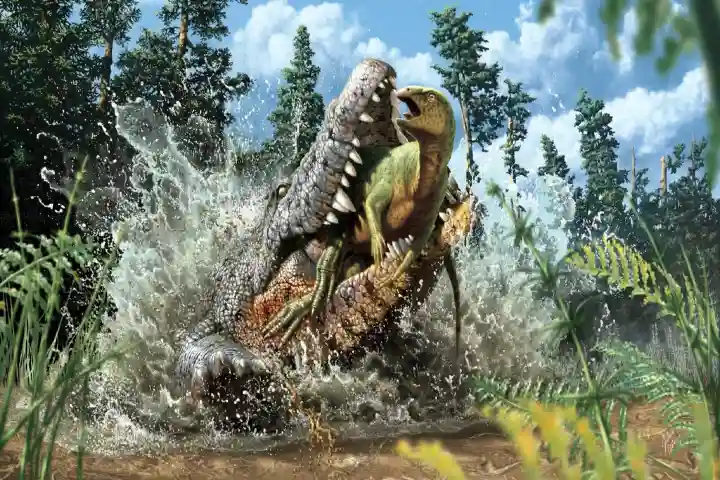Recently scientists in Australia found remains of an ancient crocodile which was different from other finds in one respect as it had inside it the creature’s last meal, a dinosaur as per a report in livescience.com.
The period was 95 million years ago when this powerful croc made a meal of a small bodied dinosaur and soon afterwards died, and became fossilised with its prey in its stomach. It was a young ornithopod that the predator had swallowed in one gulp – belonging to the most bipedal herbivore group.
The remains of this giant crocodile and its meal were found in the Great Australian Super Basin, a site which dates to the Cretaceous period which is 145.5 million to 65.5 million years ago. The fossil’s tail, hind limbs and a good part of the pelvis were not there but the skull, many bones of the body were complete.
Also read: 240 million years ago, Tanzania’s ancient crocodile was the largest predator that roamed the planet
When it died, the crocodile was more than eight feet long and would have become bigger had it lived, stated the scientists in their study.
The remains of the giant was called Confractosuchus sauroktonos. The tongue twister name includes information about the new genus and species. Translated from the Latin and Greek words it in sum means "broken crocodile dinosaur-killer”, as per the study. The contents of the stomach provided “dinosaur-killer" while "broken" referred to the stony matrix surrounding the fossil which during the excavation in 2010 broke and unveiled the smaller bones inside the croc’s abdomen.
In the beginning of the Triassic period that is 251.9 million to 201.3 million years ago, the crocodilians coexisted with dinosaurs. There is proof that some of the dinosaurs formed a part of the crocs’ diet. Instances of fossilised bones of dinosaurs having tooth marks and one having a tooth lodged in the bone, point out that these creatures were either stalked or scavenged by crocodiles. Preserved contents of a crocodile's stomach had been rarely found and this case was the first firm evidence of the dinosaurs being hunted by the crocs, said the researchers in the study that was published in Gondwana Research, a journal.
Also read: 246 million years ago, giant reptiles with 8-foot-long skull dominated the Earth’s oceans
The dinosaur’s bones were delicate and to avoid moving them, the scientists scanned the abdomen of the crocodile with X-ray computed tomography (CT) devices and created digital 3D models of the delicate bones. After calculations they concluded that the ornithopod weighed about 1.7 kilograms and while gobbling it up the crocodile broke one of its femurs in half while in the other left a tooth embedded.
Talking about this fossil, the study’s lead Matt White who is a research associate at the Australian Age of Dinosaurs Museum, in a statement said: "It is likely dinosaurs constituted an important resource in the Cretaceous ecological food web. Given the lack of comparable global specimens, this prehistoric crocodile and its last meal will continue to provide clues to the relationships and behaviours of animals that inhabited Australia millions of years ago."




















